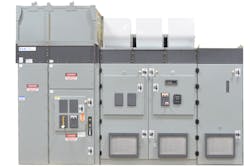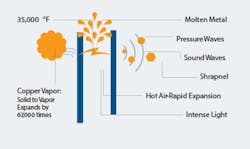For more than 40 years, adjustable frequency drives (AFDs) have reduced energy costs and the wear and tear on valuable equipment. To further this energy consumption reduction, organizations, including the U.S. Department of Energy, continue to support the development of even more sophisticated drive technology.
However, today’s drives provide more than reduced energy costs. Some AFD technology addresses the danger of arc flash events, which can instantaneously generate temperatures in excess of 35,000 degrees (three times hotter than the sun). By focusing on arc flash safety, organizations can reduce the risk to personnel and avoid equipment damage while reducing system downtime.
In heavy power, continuous-operation industries, arc flash poses a real threat. Environments operating with 125 kilovolt ampere (kVA) or larger transformers call for special safety measures.
An arc flash is the explosive release of energy caused by an electrical arc because of a phase-to-ground or a phase-to-phase fault. This kind of fault can result from many factors, including:
- A dropped tool
- Accidental contact with electrical conductors
- Conductive dust buildup
- Corrosion
- Improper work conditions
An arc flash releases a tremendous amount of energy in the form of thermal heat, toxic fumes, pressure and sound waves, light, and explosions. To protect against these events, arc-resistant technology is now available for medium-voltage drives. It combines AFD technology with certified arc-resistant features to reduce energy costs; minimize unplanned downtime; reduce equipment damage; and improve safety across water and wastewater, oil and gas, utility, and other critical applications.
Arc flash safety technology
The effects of an arc flash event
For years, electrical equipment has been designed to withstand a bolted fault. Protective devices in the equipment (breakers, fuses and relays) interrupt the currents when they spike to a dangerously high level. However, these devices do not typically detect and interrupt internal arcing faults, which have lower current levels but can cause more danger.
To resolve this, reducing the duration of an event by tripping a breaker or blowing a fuse significantly reduces the energy during an arc flash incident. Increasing the distance between personnel and equipment through remote operation or with closed doors or protective barriers also helps to protect workers in case of an arc flash event.
The National Fire Protection Agency (NFPA) Article 70E: Standard for Electrical Safety in the Workplace identifies safe practices for personnel who work on energized equipment to limit injuries. NFPA Article 70E 340.7 states that an employer is responsible for qualified personnel training to explain the potential hazard, develop strategies to minimize those hazards, provide methods to avoid arc flash hazards and convey the necessity of reporting hazardous incidents. ThisA key step in this process, arc flash incident energy analysis, quantifies the incident energy that will be released during an arc flash event at each location in the electrical system. The results of the analysis are printed on an arc flash label so that the qualified electrical worker can determine the appropriate PPE to wear during energized electrical work.
Installing the right equipment can also help mitigate arc flash hazards. Specially designed AFDs, motor control centers (MCCs) and switchgear can reduce the probability of electrical shock and arc flash energy during maintenance. More specifically, arc-resistant technology contains and redirects the arc energy up and away from the user, regardless of where the arc originates.
Arc-resistant switchgear and MCCs have been around for years, while drives have first met the applicable arc-resistant standards in 2015.
Does arc-resistant technology limit functionality?
Just because a drive is arc resistant does not mean that its functionality is limited. Arc-resistant technology can affect equipment footprint, configuration or weight, but it should not adversely impact drive functionality.
Medium-voltage drives can enable synchronous transfer, regardless of whether the version used is arc-resistant. This allows a single drive to control power to multiple motors and reduce equipment costs, so multiple drives do not need to be used. Integrated control technology with a common bus for synchronous transfer helps eliminate significant cabling expense and lowers overall equipment cost. The dual bus system saves energy and reduces installation costs, while arc resistant versions minimize and help prevent arc faults.
Enhancing safety while advancing energy efficiency
Establishing a culture that actively supports electrical safety involves more than using arc-resistant technology. Avoiding the dangers associated with arc flash and shock hazards require conscious decisions and commitments from everyone, including maintenance electricians and operators, facility managers, and business leaders.
By using arc-resistant technology, organizations can reduce the probability of electrical shock and an arc flash incident during maintenance. Arc-resistant drives can be used with switchgear and MCCs designed to reduce hazards in the electrical distribution system.





